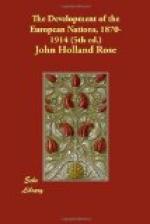But his time of tyranny soon drew to a close. A woman of Khartum, who had been outraged by him or his followers, determined to wreak her vengeance. On June 14, 1885, she succeeded in giving him slow poison, which led him to his death amidst long-drawn agonies eight days later. This ought to have been the death of Mahdism as well, but superstitions die hard in that land of fanatics. The Mahdi’s factotum, an able intriguer named Abdullah Taashi, had previously gained from his master a written declaration that he was to be Khalifa after him; he now produced this document, and fortified its influence by describing in great detail a vision in which the ghost of the Mahdi handed him a sacred hair of inestimable worth, and an oblong-shaped light which had come direct from the hands of the true Prophet, who had received it from the hands of the angel Gabriel, to whom it had been entrusted by the Almighty.
This silly story was eagerly believed by the many, the questioning few also finding it well to still their doubts in presence of death or torture. Piety and politics quickly worked hand in hand to found the impostor’s authority. A mosque began to rise over the tomb of the Mahdi in his chosen capital, Omdurman; and his successor gained the support and the offerings of the thousands of pilgrims who came to visit that wonder-working shrine. Such was the basis of the new rule, which spread over the valley of the Upper and Middle Nile, and carried terror nearly to the borders of Egypt[407].
[Footnote 407: Wingate, Mahdism, pp. 228-233.]




